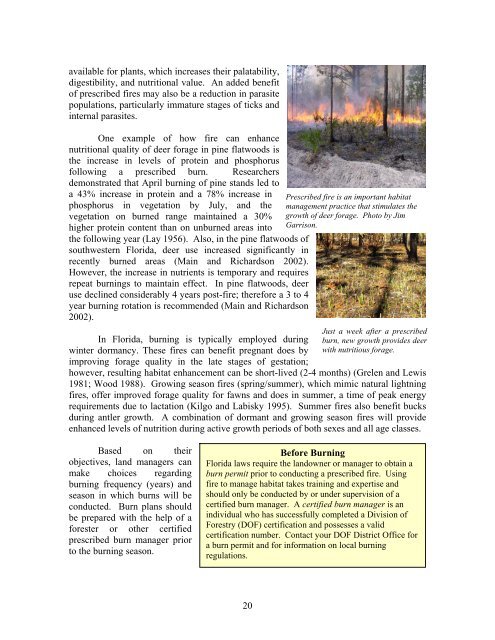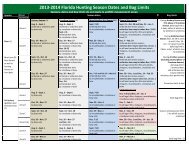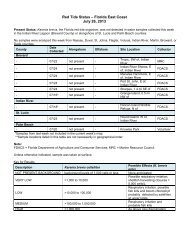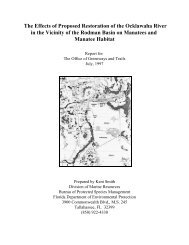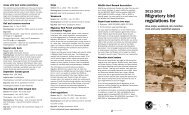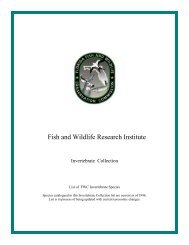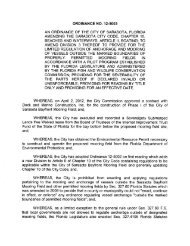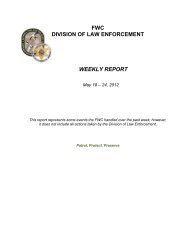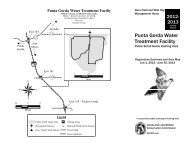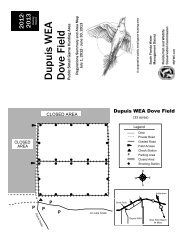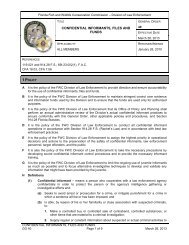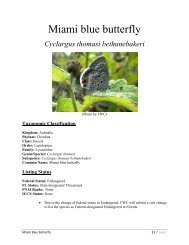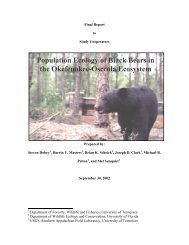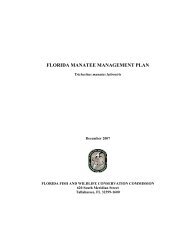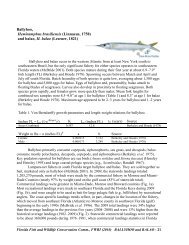Ecology and management of white-tailed deer in - Florida Fish and ...
Ecology and management of white-tailed deer in - Florida Fish and ...
Ecology and management of white-tailed deer in - Florida Fish and ...
You also want an ePaper? Increase the reach of your titles
YUMPU automatically turns print PDFs into web optimized ePapers that Google loves.
available for plants, which <strong>in</strong>creases their palatability,<br />
digestibility, <strong>and</strong> nutritional value. An added benefit<br />
<strong>of</strong> prescribed fires may also be a reduction <strong>in</strong> parasite<br />
populations, particularly immature stages <strong>of</strong> ticks <strong>and</strong><br />
<strong>in</strong>ternal parasites.<br />
One example <strong>of</strong> how fire can enhance<br />
nutritional quality <strong>of</strong> <strong>deer</strong> forage <strong>in</strong> p<strong>in</strong>e flatwoods is<br />
the <strong>in</strong>crease <strong>in</strong> levels <strong>of</strong> prote<strong>in</strong> <strong>and</strong> phosphorus<br />
follow<strong>in</strong>g a prescribed burn. Researchers<br />
demonstrated that April burn<strong>in</strong>g <strong>of</strong> p<strong>in</strong>e st<strong>and</strong>s led to<br />
a 43% <strong>in</strong>crease <strong>in</strong> prote<strong>in</strong> <strong>and</strong> a 78% <strong>in</strong>crease <strong>in</strong> Prescribed fire is an important habitat<br />
phosphorus <strong>in</strong> vegetation by July, <strong>and</strong> the <strong>management</strong> practice that stimulates the<br />
vegetation on burned range ma<strong>in</strong>ta<strong>in</strong>ed a 30% growth <strong>of</strong> <strong>deer</strong> forage. Photo by Jim<br />
higher prote<strong>in</strong> content than on unburned areas <strong>in</strong>to Garrison.<br />
the follow<strong>in</strong>g year (Lay 1956). Also, <strong>in</strong> the p<strong>in</strong>e flatwoods <strong>of</strong><br />
southwestern <strong>Florida</strong>, <strong>deer</strong> use <strong>in</strong>creased significantly <strong>in</strong><br />
recently burned areas (Ma<strong>in</strong> <strong>and</strong> Richardson 2002).<br />
However, the <strong>in</strong>crease <strong>in</strong> nutrients is temporary <strong>and</strong> requires<br />
repeat burn<strong>in</strong>gs to ma<strong>in</strong>ta<strong>in</strong> effect. In p<strong>in</strong>e flatwoods, <strong>deer</strong><br />
use decl<strong>in</strong>ed considerably 4 years post-fire; therefore a 3 to 4<br />
year burn<strong>in</strong>g rotation is recommended (Ma<strong>in</strong> <strong>and</strong> Richardson<br />
2002).<br />
In <strong>Florida</strong>, burn<strong>in</strong>g is typically employed dur<strong>in</strong>g<br />
w<strong>in</strong>ter dormancy. These fires can benefit pregnant does by<br />
improv<strong>in</strong>g forage quality <strong>in</strong> the late stages <strong>of</strong> gestation;<br />
Just a week after a prescribed<br />
burn, new growth provides <strong>deer</strong><br />
with nutritious forage.<br />
however, result<strong>in</strong>g habitat enhancement can be short-lived (2-4 months) (Grelen <strong>and</strong> Lewis<br />
1981; Wood 1988). Grow<strong>in</strong>g season fires (spr<strong>in</strong>g/summer), which mimic natural lightn<strong>in</strong>g<br />
fires, <strong>of</strong>fer improved forage quality for fawns <strong>and</strong> does <strong>in</strong> summer, a time <strong>of</strong> peak energy<br />
requirements due to lactation (Kilgo <strong>and</strong> Labisky 1995). Summer fires also benefit bucks<br />
dur<strong>in</strong>g antler growth. A comb<strong>in</strong>ation <strong>of</strong> dormant <strong>and</strong> grow<strong>in</strong>g season fires will provide<br />
enhanced levels <strong>of</strong> nutrition dur<strong>in</strong>g active growth periods <strong>of</strong> both sexes <strong>and</strong> all age classes.<br />
Based on their<br />
objectives, l<strong>and</strong> managers can<br />
make choices regard<strong>in</strong>g<br />
burn<strong>in</strong>g frequency (years) <strong>and</strong><br />
season <strong>in</strong> which burns will be<br />
conducted. Burn plans should<br />
be prepared with the help <strong>of</strong> a<br />
forester or other certified<br />
prescribed burn manager prior<br />
to the burn<strong>in</strong>g season.<br />
Before Burn<strong>in</strong>g<br />
<strong>Florida</strong> laws require the l<strong>and</strong>owner or manager to obta<strong>in</strong> a<br />
burn permit prior to conduct<strong>in</strong>g a prescribed fire. Us<strong>in</strong>g<br />
fire to manage habitat takes tra<strong>in</strong><strong>in</strong>g <strong>and</strong> expertise <strong>and</strong><br />
should only be conducted by or under supervision <strong>of</strong> a<br />
certified burn manager. A certified burn manager is an<br />
<strong>in</strong>dividual who has successfully completed a Division <strong>of</strong><br />
Forestry (DOF) certification <strong>and</strong> possesses a valid<br />
certification number. Contact your DOF District Office for<br />
a burn permit <strong>and</strong> for <strong>in</strong>formation on local burn<strong>in</strong>g<br />
regulations.<br />
20


